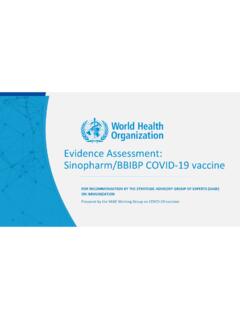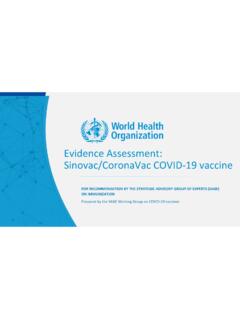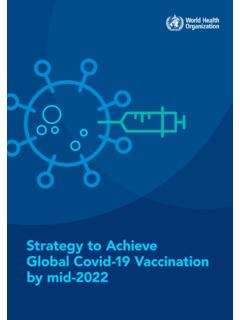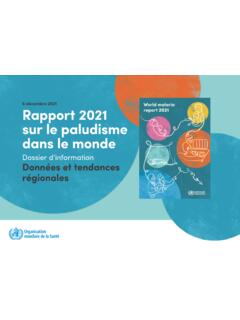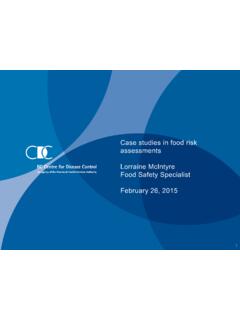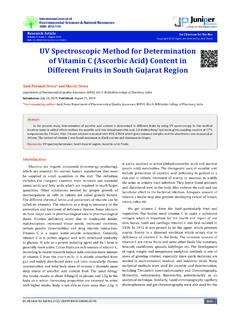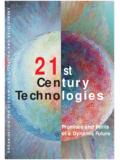Transcription of Annex 3 - World Health Organization
1 137 Introduction 139 General considerations 139 Special considerations 140 Scope of the Recommendations 141 BCG vaccine strains 141 Potency-related tests 142 Part A. Manufacturing recommendations Definitions General manufacturing recommendations Control of source materials Control of vaccine production Filling and containers Control tests on final lot Records Retained samples Labelling Distribution and transport stability , storage and expiry date 157 Part B. Nonclinical evaluation of BCG vaccines 159 Part C. Clinical evaluation of BCG vaccines General considerations Special considerations Post-marketing surveillance 164 Part D. Guidelines for NRAs General Release and certification 166 Authors and acknowledgements 166 References 170 Annex 3 Recommendations to assure the quality, safety and efficacy of BCG vaccinesReplacement of Annex 2 of WHO Technical Report Series, No.
2 745, and Amendment to Annex 12 of WHO Technical Report Series, No. 771138 WHO Technical Report Series No. 979, 2013 WHO Expert Committee on Biological Standardization Sixty-second reportRecommendations published by the WHO are intended to be scientific and advisory in nature. Each of the following sections constitutes guidance for national regulatory authorities (NRAs) and for manufacturers of biological products. If an NRA so desires, these Recommendations may be adopted as definitive national requirements, or modifications may be justified and made by the NRA. It is recommended that modifications to these Recommendations be made only on condition that such modifications ensure that the vaccine is at least as safe and efficacious as that prepared in accordance with the recommendations set out below.
3 The parts of each section printed in small type are comments for additional guidance, intended for the benefit of manufacturers and 1 History and genealogy of BCG substrains 174 Appendix 2 Summary protocol for manufacturing and control of BCG vaccine 175 Appendix 3 Model certificate for the release of BCG vaccine by NRAs 184 Annex 3139 IntroductionThe last revision of the Requirements for dried bacille Calmette Gu rin (BCG) vaccine for human use was in 1985, and an amendment which updated the section on the expiry date was published in 1988 (1, 2). Recent WHO consultation meetings (3 6) have addressed issues concerning the improvement of vaccine characterization and quality control assays of BCG vaccine to reflect current state-of-the-art technology.
4 In addition, a recommendation to replace the International Reference Preparation for BCG vaccine by substrain-specific Reference Reagents evaluated by collaborative studies has been proposed. This document provides: recommendations for the production and control of BCG vaccines (Part A); guidelines for nonclinical evaluation (Part B); guidelines for the content of the clinical development programme applicable to BCG vaccines (Part C); and recommendations for NRAs (Part D). The guidelines for nonclinical evaluation apply to classic BCG vaccine products that are still in need of such evaluation, including newly manufactured products requiring clinical trial studies or those produced following changes in the manufacturing process.
5 The clinical part of this document aims to provide a basis for assessment of efficacy and safety of BCG vaccines in pre-licensing clinical trials as well as in post-marketing surveillance, monitoring consistency of production and clinical testing of new classic BCG vaccine products. If important changes have been introduced to an authorized production process, the need for preclinical and clinical testing should be considered on a case-by-case basis in consultation with the NRA(s) considerationsTuberculosis (TB) was declared a global emergency by WHO in 1993, and Mycobacterium tuberculosis (M. tuberculosis) is now considered to be responsible for more adult deaths than any other pathogen.
6 Vaccination with BCG still remains the standard for TB prevention in most countries because of its efficacy in preventing life-threatening forms of TB in infants and young children. It is inexpensive and usually requires only one administration in either newborns or adolescents (7, 8). As there is currently no suitable alternative, BCG will remain in use for the foreseeable future and may continue to be used as a prime vaccine in a prime-boost immunization schedule in conjunction with new TB vaccines (4).BCG vaccine contains a live, attenuated strain of M. bovis that was originally isolated from cattle with tuberculosis and cultured for a period of 13 years and a total of 231 passages (7). The BCG vaccine was first used to immunize humans in 1921.
7 Following its introduction into the WHO Expanded Programme on Immunization (EPI) in 1974, the vaccine soon reached global coverage rates exceeding 80% in countries endemic for TB (9).140 WHO Technical Report Series No. 979, 2013 WHO Expert Committee on Biological Standardization Sixty-second reportOver the years, different BCG vaccine seed strains have evolved from the original vaccine strain for production. A number of BCG vaccine strains that are used worldwide differ in terms of their genetic and phenotypic properties, and their reactogenicity and immunogenicity profile when given to infants and children. With this background of a diversity of substrains, manufacturing processes, immunization schedules and levels of exposure to environmental mycobacteria and virulent M.
8 Tuberculosis infection, different levels of protective efficacy of BCG vaccines in adult populations have been reported (10). However, the data are insufficient to make recommendations on whether one strain should be preferred over the other (11). The United Nations agencies are the largest supplier of BCG vaccines, distributing more than 120 million doses each year to more than 100 countries. Worldwide, the most commonly used vaccine strains are currently Danish 1331, Tokyo 172-1 and Russian BCG-I because they are supplied by the United Nations Children s Fund (UNICEF) which purchases the vaccines through a published prequalification process which determines their eligibility for use in national immunization programmes (12).
9 There has been particular concern over the safety of BCG vaccination in subjects infected with the human immunodeficiency virus (HIV) (8). WHO previously recommended that in countries with a high burden of TB, a single administration of BCG vaccine should be given to all healthy infants as soon as possible after birth, unless the child presented a symptomatic HIV infection (9). However, recent evidence shows that children who were HIV-infected when vaccinated with BCG at birth, and who later developed acquired immunodeficiency syndrome (AIDS), were at increased risk of developing disseminated BCG disease. Among these children, the benefits of potential prevention of severe TB are outweighed by the risks associated with the use of BCG vaccine; thus the use of BCG vaccines at birth in relation to HIV-infected infants should follow the recommendations of the Global Advisory Committee on Vaccine Safety (GACVS) (13, 14).
10 Special considerationsThe formulation of international requirements for freeze-dried BCG vaccine is complicated by the following: (a) a number of different substrains derived from the original strain of BCG are used in vaccine manufacture; (b) a number of different manufacturing and testing procedures are employed; (c) it is difficult to identify a link between significant differences in vitro and in vivo between different BCG vaccine strains and any possible differences in protective efficacy against TB in humans; (d) vaccines are produced with different total bacterial content and numbers of culturable particles; and (e) vaccines intended for administration by different routes are prepared. Therefore, the following considerations should be borne in mind regarding the scope of these recommendations, BCG vaccine strains, and potency-related 3141 Scope of the RecommendationsThese revised Recommendations refer to freeze-dried BCG vaccines prepared from substrains derived from original BCG for use in the prevention of TB.
